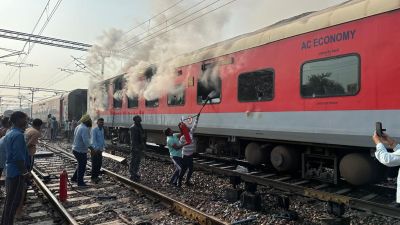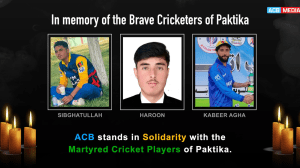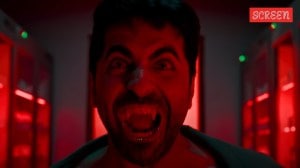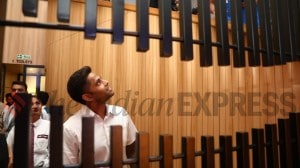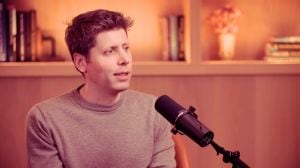Stay updated with the latest - Click here to follow us on Instagram
At least 300 dead, curfew back: Why have protests and violence returned to the streets of Bangladesh?
The anti-government protesters across Bangladesh have planned to march to the capital, Dhaka, on Monday.
 Men run past a burning vehicle inside the Bangabandhu Sheikh Mujib Medical University Hospital, set on fire by protesters. (AP Photo)
Men run past a burning vehicle inside the Bangabandhu Sheikh Mujib Medical University Hospital, set on fire by protesters. (AP Photo)Fresh violence broke in Bangladesh on Monday leaving at least 300 dead as it witnessed a revival of students’ stir following the deadly government crackdown late last month. The government has imposed countrywide curfews and curbs on mobile internet.
People took to the streets on Sunday against the government once again, demanding Prime Minister Sheikh Hasina’s resignation. The protests last month had begun with students calling for an end to a quota in government jobs for families of veterans who fought in Bangladesh’s war of independence against Pakistan in 1971. Reacting to the fresh violence, Hasina said the protesters who engaged in “sabotage” and destruction were no longer students but criminals.
Meanwhile, the Ministry of External Affairs in India has advised all citizens to avoid travelling to Bangladesh and those residing there to exercise extreme caution, restrict their movements and remain in touch with the High Commission in Dhaka.
Why have the protesters hit the streets again?
The fresh wave of violence began after protesters called for a “non-cooperation” effort, urging people not to pay taxes or utility bills and not to show up for work on Sunday. Offices, banks and factories opened, but commuters in Dhaka and other cities faced challenges getting to their jobs.
 People participate in a rally against Prime Minister Sheikh Hasina and her government demanding justice for the victims killed in the recent countrywide deadly clashes, in Dhaka, Bangladesh, Sunday, Aug. 4, 2024. (AP Photo)
People participate in a rally against Prime Minister Sheikh Hasina and her government demanding justice for the victims killed in the recent countrywide deadly clashes, in Dhaka, Bangladesh, Sunday, Aug. 4, 2024. (AP Photo)
The demonstrators attacked Bangabandhu Sheikh Mujib Medical University, a major public hospital in Dhaka’s Shahbagh area, torching several vehicles. Video footage showed protesters vandalizing a prison van in the chief metropolitan magistrate’s court in Dhaka. Other videos showed police opening fire on the crowds with bullets, rubber bullets and tear gas. The protesters set fire to vehicles and the ruling party’s offices. Some carried sharp weapons and sticks, according to TV footage.
In Dhaka’s Uttara neighborhood, police fired tear gas to disperse hundreds of people who blocked a major highway. Protesters attacked homes and vandalized a community welfare office in the area, where hundreds of ruling party activists took up positions. Some crude bombs were detonated, and gunshots were heard, witnesses said.
What is the root cause of the protests?
Less than a month ago, demonstrations began around the country demanding an end to the 30 per cent quota on government jobs for families of veterans who fought in the country’s war against Pakistan in 1971. The Supreme Court, then, had ruled that the veterans’ quota must be cut to 5 per cent, with 93 per cent of jobs being allocated on merit. The remaining 2 per cent will be set aside for members of ethnic minorities and transgender and disabled people, according to AP.
Although the government accepted the SC’s decision, protesters continued to demand accountability for the violence which they blamed on the government’s use of force, AP reported.
At least 11,000 people have been arrested in recent weeks, the report said.
What has Sheikh Hasina’s government said about the protests?
Prime Minister Sheikh Hasina has accused the protesters of “sabotage” and cut off mobile internet services to crush dissent. A curfew has been in place since Sunday evening for an indefinite period in Dhaka, divisional and district headquarters.
Hasina said that the protesters who engaged in “sabotage” and destruction were no longer students but criminals, and that people should deal with them with iron hands. The ruling Awami League party, moreover, said the demand for Hasina’s resignation showed that the protests have been taken over by the main opposition Bangladesh Nationalist Party and the now-banned Jamaat-e-Islami party, AP reported.
 Smoke rises from a fire that was set on the street during a protest by students demanding the stepping down of Bangladeshi Prime Minister Sheikh Hasina, following quota reform protests, in Dhaka, Bangladesh, August 4, 2024. (Photo: Reuters)
Smoke rises from a fire that was set on the street during a protest by students demanding the stepping down of Bangladeshi Prime Minister Sheikh Hasina, following quota reform protests, in Dhaka, Bangladesh, August 4, 2024. (Photo: Reuters)
Further, according to the report, the PM’s administration has continued to blame the student wings of opposition parties for instigating violence in which several state-owned establishments were torched or vandalized. Mirza Fakhrul Islam Alamgir, Secretary-General of the BNP, repeated a call for the government to step down to stop the chaos.
Hasina also offered to talk with student leaders on Saturday, however, a coordinator refused and announced a one-point demand for her resignation, the news agency reported. Hasina repeated her pledges to investigate the deaths and punish those responsible for the violence. She said she was ready to sit down whenever the protesters wanted as the protests have become a major challenge for Hasina, who has ruled the country for over 15 years. She returned to power for a fourth consecutive term in January in an election that was boycotted by her main opponents, the AP report noted.
What all services have been shut amid the violence in Bangladesh?
Amid the protests, the government announced a holiday from Monday to Wednesday, the news agency reported. The report also said that courts were to be closed indefinitely.
Mobile internet services have been cut off, while Facebook and messaging apps, including WhatsApp, have become inaccessible.
AP reported Junior Minister for Information and Broadcasting Mohammad Ali Arafat as saying that the services were severed to help prevent violence.
The unrest has resulted in the closure of schools and universities across the country, and authorities at one point imposed a shoot-on-sight curfew, according to the report.
What are the protesters planning as their next step?
The anti-government protesters across Bangladesh have planned to march to the capital, Dhaka, on Monday.






- 01
- 02
- 03
- 04
- 05


